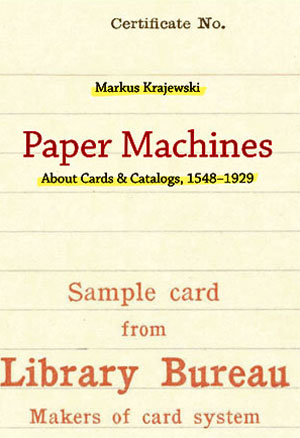
Today, on just about every desk there is a gray box emitting a range of wires. Eighty years ago, this data processing box was less conspicuous, non-electronic, and made from wood—a literal paper machine.
My book explores the way this indexing “machine” set out on its triumphant march, entering offices and orderly rooms around 1930 as a universal and crucial instrument for data processing, and eventually transmuting into the “Universal Machine” known as the computer.
Paper Machines follows the development of the index card along its various historical breaches, beginning with the first references to the indexing of knowledge in early modern times. The book examines the almost accidental introduction and gradual assertion of card index boxes in libraries around 1800 and glances at the production conditions of literature with the aid of index files, before suggesting a discursive transference between the institutions of writing—libraries and offices.
Among the book’s protagonists are—besides the Swiss polymath Conrad Gesner, one of the most influential classificators of the 16th century—Melvil Dewey, known as the father of the Decimal Classification System, and William Croswell, yet unknown as America’s laziest librarian, but inventor of Harvard College Library’s card catalog in 1812.
Paper Machines unfolds the long history of the index card from the Baroque Period to the dawning age of electronic communication in an unexpectedly amusing way: as a history of failures. It is an astonishing story, and not only for librarians, bibliophiles and historians of the art of unelectronic data processing.
Since this is a history of information pieces and how they relate to each other, the text may also be read in different—and probably uncommon—ways rather than simply chronologically.
The ideal way for reading the bound book would be to cut all the episodes into pieces, shuffle them, rearrange them into the specific idiosyncratic flow in which you would like to consume this story. Mark the references you like most, link them to other passages within in the text and outside, draw connections to other stories and texts you know from different contexts or to those texts in your personal database. Implement this story about weaving information into your own network of knowledge production.
Paper Machines outlines the story of the card index in manifold ways: as a library catalogue, as a collection for thinkers, and as a tool for office efficiency. And yet it outlines a whole genealogy from its primordial scene in 1548, when a Zurich based polymath named Conrad Gesner starts thinking about cutting information into pieces, up to 1929, the beginning of the electrical era in the office and the new age of data processing.
This book deals with the history of a crucial cultural technique which has been neglected so far, though it operates on the very basis of our intellectual life: freely moving around pieces of data on paper slips is one way to cope with the notorious information overflow. Before the dawn of the computer age information was usually stored on paper, often kept in notebooks for further use. I argue that the card index is the obvious precursor of the computer as a data processing device.
Paper Machines unfolds the history of cutting those papers of thinking in pieces instead of keeping them in bound form, and how those mobile elements provide a specific advantage not only for data processing purposes or for library use. Furthermore paper slips serve as very basic as well as productive tools of thinking for both, more efficient handling and—what is more—for scholarly purposes.
The main thesis focuses on the often hidden, unmentioned learned practices which paper slips or index cards provide as a fundamental device for thinking. Paper Machines argues, beyond the long history of the book, in favor of an alternative genealogy of data processing and information flow which is—despite its elements—deeply rooted in our cultural technology.
The narrative makes a strong contribution to a new historiographical approach, i.e. developing an argumentation in an entertaining as well as theoretically challenging manner. That’s the way how media theory could be fun.
The nucleus for writing the history of the card index was set after I’d for some time been developing Synapsen, a software that serves as my personal hypertextual card index. While working on the code I wondered about the longer history of this very tool as a thinking device. And so, I started reading and researching. First I read the sources which were already fed into my “Synapsen,” then I visited different archives and excerpted more material which gradually flooded my narrative.
But thanks to my software the line of argumentation could be saved from drowning—it could be even enriched and streamlined at the same time, due to my electronic card index which tended to write its own history almost without further help.
A book is usually not considered a machine—though it is common to use paper as one of the book’s core elements and a machine to print its pages.
If you open a book called Paper Machines on page 95, you may read about an incident where nothing less than a historical change within the long tradition of economical bookkeeping was invented. This crucial scene took place in a Boston company called Library Bureau and it was lead by America’s foremost librarian of the 19th century: Melvil Dewey, the inventor of the famous library classification system.
Dewey’s secretary, E.W. Sherman, also plays a major role. She used card catalogs not only for libraries but for her own commercial bookkeeping, and her visionary insight in applying library furniture to financial transactions leads to the ubiquitous spread of card indexes on every office desk around 1900.
However, this is only one small episode in a longer trajectory. Others could be mentioned. For example, around 1700, the famous polymath Gottfried Wilhelm Leibniz stored his information in a specially designed cupboard on paper slips which were hooked on long battens, freely moveable and arrangeable in new orders. Or, the Nobel prize winner in Chemistry, Wilhelm Ostwald, sought to store all available information of all time and all nations at one single spot in Munich in a huge collection of index cards. This project, called The World Brain, began in 1911 and ended already in 1913 with a tiny collection of postcards of the Bavarian town of Ansbach.
What happens if you suddenly realize that your personal card index knows more than you? How can this sometimes intimate relationship be described? And what are the poetological effects on the writing scene if you simply communicate with your wooden as well as learned machine—your externalized brain which even promises to write your texts?
The personal slip box offers an interface which is more than just a pleasant sight of an apparatus made either from paper and wood or from bits and bytes. The apparatus delivers those keywords which stimulate the scholar to further thought production in response to a simple touch of the interface. The previously silent Other becomes a proper interlocuter. The finely-branched network of connections guarantees that the keywords which are subsequently exchanged appear by no means haphazardly. For over the course of the operation, these keywords gradually cultivate a kind of second memory. And the apparatus itself serves, to borrow Immanuel Kant’s phrase, as a “midwifery of thought.”
Paper Machines not only gives answers to those questions, it also provides the appropriate praise of the link or cross-reference as a productive way of imagining new thoughts and lines of argumentation. If reading the book would inspire others to rethink their way of handling information or to start wondering how the media determines our way of thinking itself, a step into a flourishing discipline would have been taken: Welcome to Media Theory!


Markus Krajewski is Associate Professor of Media History of Science at Bauhaus University Weimar, and has been a fellow at the Humanities Center at Harvard University. Besides Paper Machines, featured on Rorotoko, he is the author of Der Diener. Mediengeschichte einer Figur zwischen König und Klient, forthcoming in English as “The Servant: Media History of a Figure between King and Client,” and Restlosigkeit: Weltprojekte um 1900. His current research projects include the history of exactitude or the epistemology of the peripheral. Markus Krajewski is also the developer of Synapsen—a hypertextual card index.